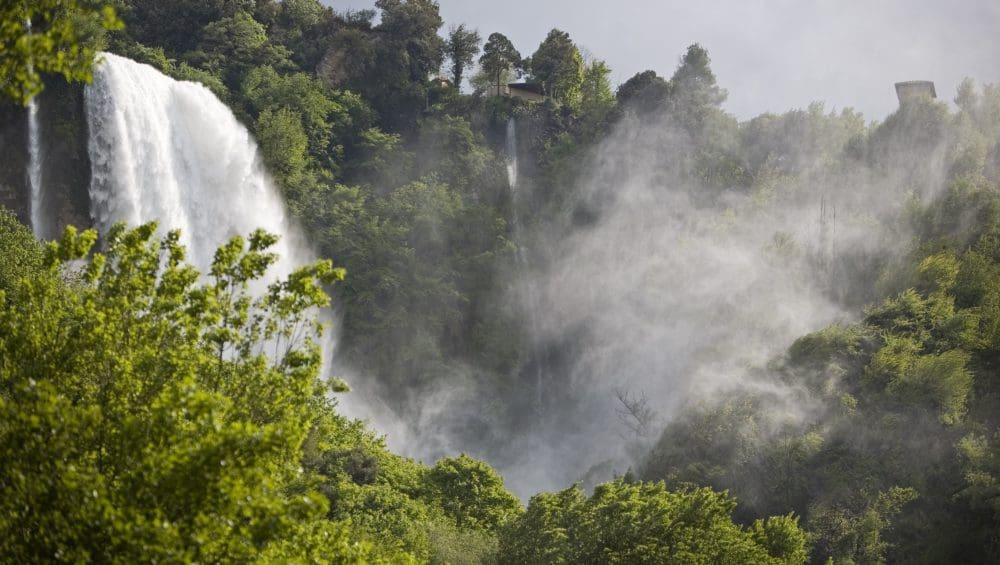The Marmore Falls, formed by the Velino and the Nera, tributaries of the Tiber, is one of the most visited natural attractions in Umbria, although it is an artificial waterfall, it has very ancient origins that date back to Roman times, in 271 BC: it is on this date that the Roman consul Manio Curio Dentato with an ingenious hydraulic intervention, built a canal in order to drain the stagnant waters of the Velino into the Sabina (Rieti plain), dangerous for the nearby population, towards the Nera river. The intervention was thus called and known over time as “Cavo Curiano”.
Other interventions made to counteract flooding during periods of river flooding date back to 1422, by the engineer Aristotile Fioravanti and entrusted by Braccio Fortebraccio da Montone. On this occasion a new canal called “reatino” was built. Other interventions date back to 1547 by Antonio Da Sangallo, commissioned by Pope Paul III with the construction of a third canal. In 1601 the architect Giovanni Fontana built the “Clementino” canal in honor of Pope Clement III. Finally in 1787 the architect Andrea Vici made the last intervention that gave the Marmore Falls their current appearance.
To date the Marmore Falls is the highest artificial waterfall in Europe.
CURIOSITIES
- The name comes from the richness of calcium carbonate on the rocks that resembles white marble.
- Today the waterfall is not only an important tourist and naturalistic attraction for the richness of flora and fauna, from algae, mosses, ferns, insects, fish, reptiles, birds and small mammals, but it is also used for hydroelectric production.
- The waterfall is not always open at full capacity (Pay attention to the opening hours so as not to miss this fascinating moment!!), and this allows you to admire the beauty and richness of the vegetation that is shown when the flow of water of the waterfall is closed. Its opening is announced through an acoustic signal. The sight of the water that throws itself with force and creates, on sunny days, a wonderful rainbow is wonderful. The waterfalls can be accessed from both the upper and lower Belvedere.
- At night, the waters of the waterfall, when open, are illuminated by a LED lighting system.
- The beauty of the Marmore Falls Park is also given by the ability to admire along the route the caves that the water has dug over the centuries with stalactites and stalagmites in the travertine: some can be visited and the most famous is the LOVERS’ CAVE
A ROMANTIC LEGEND
The Gnefro, a legendary fairy creature of Umbrian popular culture, tells the story of the nymph named Nera infatuated with the shepherd Velino. The goddess Juno, who did not accept a love between a nymph and a human being, transformed the Nymph Nera into a river. Velino, believing that the Nymph Nera was drowning in those previously unknown waters, threw himself into them. However, Jupiter, moved by pure love, also transformed the shepherd Velino into a river. From then on, the river Nera and the river Velino could stay together for eternity.
DID YOU KNOW THAT
- The soprano Gina Palmucci, deeply in love with her territory, being of Terni origins, chose as her stage name Nera Marmora;
- The Marmore Falls have been painted by several painters and described by important literary figures such as Lord Byron;
- It is present in many films such as Intervista by Federico Fellini in 1987, the Stendhal Syndrome by Dario Argento in 1996, and also in fiction such as Don Matteo;
- In 2011 it was the location for the concert with the orchestra
“I Filarmonici di Roma” and in 2012 the concert for the “Tributo a Sergio Endrigo” by Simone Cristicchi; - In 2017, it was the protagonist of the advertising campaign for the promotion of Tourism in Umbria together with the former Italian diver Tania Cagnotto;
- In January 2023, it was the location for the external test of the MasterChef program.



